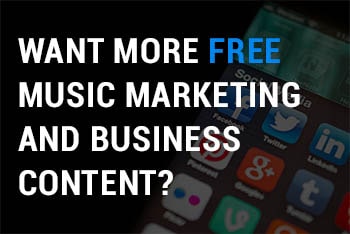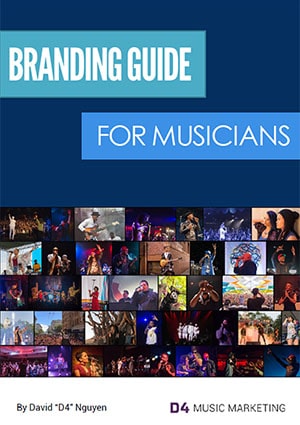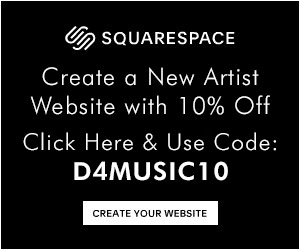
EXPOSURE. It’s what all artists want right?
After investing so much time into creating the music, you want to make sure it gets in front of people. How can you get your music in front of new potential fans? Maybe you’re unsure of the options you have.
A few people have reached out to me and asked about how to get more exposure. To me, there’s really no big secret.
The goal of this blog is to simplify the most practical routes to get more exposure for your music. It’s less about secret tactics or hacks, and more so about an overview of all your options you have to get your music in front of new people.
I break down getting exposure into two general categories:
- Channels you can control / Building your own audience
- Leveraging other people’s audience
Channels you can control / Building your own audience
Market music properly and make it accessible
If you’re putting out good music and doing your due diligence to get your songs out there and making it easily accessible. The more places people can get to your music, the more likely you can expose it to them. This will largely depend on what music business model you follow or what your views are regarding giving your music for free.
Optimize your social media channels and make sure you use hashtags and proper tags so it can be discovered.
Don’t just post the song once and move onto the next thing. You really have to promote it multiple times (not too much where you become spammy), but also re-purpose the song into different content like videos.
Keep making music consistently
One of the biggest challenges with getting exposure for your music is that there’s just so much competition. Attention is hard to come by and the fact is not all artists have the ability to gain a lot of exposure.
Mediocre songs will get a mediocre response. Getting exposure often starts with a really good song that people will want to share naturally that resonates with listeners. It could be because it’s something that has a unique sound. Or it could be something that generates some controversy, intentionally or unintentionally (Hobo Johnson, Rich Brian, Post Malone).
For example, look at what happened with Lil Nas X with his hip hop country crossover hit “Old Town Road”.
There’s a lot of musicians out there that want things to happen quickly, but most don’t want to put the time, energy and money necessary to be a successful independent artist.
At the end of the day, you’re still going to need to make a “good” song so keep creating. Even songs that are really good will fade and fans will just jump to the next one. To keep up with the current state of the music industry, you have to be able to keep putting out new content consistently.
By putting out more music, the opportunities you have to get exposure increases the chance for something to catch on. Look at Russ for example. It’s not to say it is absolutely necessary to go that extreme, but your chances are technically increased with each new release. It’s a numbers game.
In case you’re new to the music business, just remember it’s better to put out singles and EPs rather than 10+ track albums.
Activate your current fans by word of mouth
Your current fan base is also a powerful tool for word of mouth exposure. We are more likely to trust and listen to a good friend’s recommendation. As the artist, you just need a really good song or video that fans naturally want to share with their own social media network and tell people they know in person.
I don’t know about you, but most new artists I hear about are from friends or people I know. It could be a direct recommendation, like “you need to check them out,” or passively from hearing the music they are listening to in a car ride.
Keep in mind, platforms like Facebook don’t want you to instruct your followers to like, comment and share your post because it’s considered “gaming” their algorithms. As a result, you can be penalized with your post’s organic reach.
If you’re just starting off and you don’t have a strong fan base yet, you’re going to need your friends, family and network to share.
Performing live
Every time you perform in front of a live audience, you have an opportunity to reach new fans.
Especially when you’re relatively new, you may end up doing song cover gigs at a bar or be the local opening act for a more established artist. It’s not as exciting as being the headliner of your show or going viral, but every new fan you connect with in-person counts and it all adds up. You just have to remember that pursuing music requires having a long game mindset. Don’t underestimate the real-life connection. Quality over quantity.
The most logical starting point is finding opportunities to perform in your community like local businesses, open mics, schools and art collectives. Once you feel good about your live performance skills, you can try doing gigs for Sofar Sounds, which hosts intimate, live performance events in 346 cities around the world.
The way it works is Sofar Sounds hosts a show at a local business with 3 curated musical acts that are a mystery to people who request tickets for a specific day. You get a 20 – 25 minute set that helps you with some exposure in your city, opportunity to sell merch and they will even compensate you now for performing. (When I first heard about them years ago, they weren’t paying anything while run by volunteers. They were heavily criticized for their practices, but it looks like they’ve changed their ways.) You can find out if Sofar Sounds is in your city and apply to perform here.
Also, when you’re performing out in public, you’ll have people record you on their phones and that’s another bit of exposure when they share with their network.
This is an extreme example, but it should get the point across. Lauren Jauregui shared some Instagram Stories of Butterscotch’s performance for Forbes Under 30 Summit 2018 in Boston to her 6+ million Instagram followers:
As you can imagine, Butterscotch got a nice influx of followers from this exposure. Most of the time, the average artist won’t be performing in front of others who have a massive social media following, but you never know who may be watching. If people are amazed at what you do, they are more likely to give you exposure to their audiences because it carries a level of social currency.
Short Form Videos: TikTok, YouTube Shorts and Instagram Reels
It’s no secret that TikTok is powerful social media platform for virality and expanding reach of your content to new people. With the massive user base, the different challenges (Open Verse Challenge) and the Duet feature, it’s easier to get more exposure now with the right video.
Instagram Reels operates similarly as a TikTok competitor and it’s clear that they want more people to use this feature. So when it comes to social media and looking for more exposure and reach, you should prioritize creating content for Reels over making regular posts and Instagram Stories.
YouTube Shorts has also entered the mix as their way of competing with TikTok in the vertical, short form video realm.
Pay for Social Media Ads
Platforms like Facebook and Instagram Ads are powerful tools to get targeted exposure at scale when done right. I am a big advocate of this approach. I’m currently working on a free eBook that will go in-depth on how to use Facebook and Instagram ads.
Yes, the downside is you need a budget dedicated to ads. I know money can be a challenge for an upcoming artist, but this is what you should be willing to invest in if you are truly serious about making a career out of music. As an independent artist, you are operating as a small business and paying for ads is a business expense you need to invest in.
After all, getting exposure organically from posting on these platforms is usually not going to cut it most of the time. Your content would need to been found through hashtags or things like Instagram’s Discovery tab, but usually, that’s not enough when so many others are doing the same thing.
Leveraging other people’s audiences
Artist Collaborations
One of the most basic forms of tapping into other people’s audience is through collaboration. Work on projects with artists that have an audience where you can cross-promote. It can start with artists in your local city or community.
In some cases, you can pay for a more established artist to be a collaborator or feature on a song. This way you’ll get exposure from their fans when your song appears on their Spotify artist profile.
Traditional Channels (TV and Radio)
Because of the internet, these traditional platforms aren’t as powerful as they use to be for exposure. Reality shows like America’s Got Talent helped to launch careers for many artists like Butterscotch back in 2007.
Even with reality talent type shows, they don’t seem to move the needle much as much as it use to for artists, unless you’re an extraordinary talent that the world has never seen. Someone I knew of, a friend’s brother who stuck around on the “The Voice: Season 9” for a few rounds, didn’t blow up as you would think with all that prime time exposure.
More recently in 2019, another singer I knew of from Sacramento went on “The Voice: Season 17” and was able to gain thousands of new followers before exiting in week 4.
Butterscotch was asked to do a few of these type of shows again in the past year or so. I watched the numbers of many of the contestants to see if the exposure in the competition helped increase their social media followers. Nothing noticeable, but of course, it depends on the show.
Many contestants from the first season of Netflix’s music reality show “Rhythm and Flow” saw sizeable bumps in their followings, even those that didn’t make it in the final rounds.
Radio is in a similar boat. As an early millennial, I stopped listening for over 15 years now. I imagine for younger generations it will continue to decline. In this day in age, playlists are the new radio. This is not to say it isn’t still possible to get exposure through traditional radio, but it’s not something I would focus on.
Retail Stores
Retail stores and local businesses need a specific public performance license to legally play copyrighted music in their stores. In other words, a business owner can’t just play music from their personal Spotify account for in-store customers. Instead of going through the hassle of obtaining licenses from different Performing Rights Organizations (PROs), they can pay a company that specializes in music streaming services for businesses.
One way to get your music into retail stores is by paying a service that can pitch programmers who control the playlists for these specific business streaming companies. What’s In-Store Music does just that. I’ve never personally used them, but it would something I’d consider for the right song. It’s free to pitch, but it costs $1,500 for each accepted song.
Local Community and Organizations
Sync Licensing Opportunities
Getting your song in a commercial, film, TV show or even video game is excellent way to get more exposure. It’s not easy, but it can be a great opportunity if a music supervisor finds your song is a good fit for the project.
Publicity and Press
Another typical route for exposure is through music blogs, online communities or local press. You can let a blog or online magazine get an exclusive to premiere your new music or video. If you have an interesting story, you might be able to get the press to cover it. For a list of 44 independent blogs that accept song submissions, you can check them out here.
Depending on where you are in your career, it may be useful to invest in a publicist who can get you into higher profile blogs and press opportunities.
Playlists
Getting your songs into popular curated playlists on platforms like Spotify, SoundCloud and Youtube is another way to get exposure for your music. Editorial playlists where the platform (like Spotify) has a curation team in-house may be a bit more difficult to get into, but you can easily submit your song to Spotify to be considered on their playlist. Best of all, it’s free!
You can try pitching to individual playlists if you can dig for their contact info somehow. Just keep in mind you’ll need to have something to offer them too, like the exposure of their playlist to your audience.
For more detailed information about how to get exposure for your music on Spotify, check out my Spotify Playlists Guide.
Pitch your music to Youtube channels and live streamers on Twitch
Youtube Creators and Vloggers could always use music for their videos. If they have a larger audience, it could be a good way to get more exposure. Before you pitch, just make sure the style or genre of music you do actually makes sense for their content. It would definitely help if you become an actual fan of their channel first and build up the relationship beforehand rather than doing it out of the blue.
Twitch.tv sees an average of 15 million active users a day. I don’t ever use Twitch or watch others play video games, but I know having your music play in the background while streamers are playing is another route to get exposure. Depending on the type of music you do, this could be a viable strategy.
Just keep in mind that platforms like Twitch and YouTube are strict about copyrighted music playing the background of live streams without proper licenses. This is considered copyright infringement under the Digital Millennium Copyright Act (DMCA). You will need to work the licensing out with anyone who wants to use your music.
Go Viral
There have been a lot of artists who have hit the exposure jackpot called virality.
Lil Nas X took over the world with his record breaking song “Old Town Road.”
Hobo Johnson went viral after posting a Tiny Desk entry video for a song called Peach Scone. I don’t think anyone ever expected that he would get put on the scene because of this video, but it happened.
Going viral is not a feasible strategy, but if you want to learn more to increase your chances, here are the 6 principles you need know.
Virality can even happen from something not even related to music where you become super famous on someone else’s platform for some random reason. You then can use that platform to create an audience for pushing your music. An example is Bhad Bhabie who became famous for saying the catchphrase “cash me outside, how ’bout dat” on Dr Phil as a 13 year old trouble maker. Although pursuing a music career was probably not her initial intent, she got a major label record deal because of her clout.
Conclusion
When you really assess the options you have for exposure, the X factors for exposure comes down to your content, your network and your brand.
At the end of the day, if you’re not putting out good songs:
No marketing is going to help.
No one is going to want to collaborate with you.
No fan is going to want to promote you.
No Facebook ads are going to save you.
No blog or press is going to cover you.
Be aware of all the options you have available and use them when you can. At the end of the day, all the exposure in the world won’t do anything for you if you’re not putting out music that gets someone’s attention.








This information was AWESOME! THANK YOU!!!!!!!!!!!!!!!!!!!!!!!!!!!!!!!